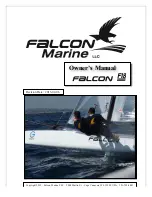
This minimizes overflow of fuel from the fuel vent. Not only can this
overflow be hazardous, but it will also adversely affect decals and pin striping
on the boat.
Always allow room in the tank for fuel expansion caused by temperature
differences. Add a fuel stabilizer that slows down the rate of fuel
decomposition. You can purchase this material at most marinas or auto supply
stores. Add the stabilizer to the tank and then fill the tank to approximately
3/4’s full.
Run the engine to circulate fuel throughout the system. This will help keep
gasoline from degrading and causing problems in the fuel system. Remember
to always follow the fuel stabilizer manufacturer’s recommendations for
proper mixing.
Note: GASOLINE EXPANDS WHEN THE TEMPERATURE INCREASES.
NEVER STORE YOUR BOAT WITH MORE THAN ABOUT 3/4’S OF A
TANK.
Gelcoat Care
Regular maintenance is the key word to keeping your hull and deck surfaces
in good-looking condition. Some of the things that will affect your boats finish
are sun exposure, residue from trees or minerals in the water.
To help maintain the shine of your boat, wash the hull with a mild bio-
degradable detergent after each use. This will help to remove any debris and
waterborne materials that are on the hull. Use a soft sponge or towel and dry
with a chamois cloth to prevent water spots.
Wax the hull sides and deck regularly. Waxes and polishes are available at a
marine supply stores. Read the directions on these products carefully before
you use them.
The hull bottom is an especially important area to keep clean since any build-
up of water scum and algae will increase create drag and reduce the boat’s
efficiency. If you must leave your boat in the water, there are marine cleaners
available to remove algae build-up on your hull. Some of these can be caustic.
Pay special attention to the cautions on the label of these coatings. Ask your
dealer for advice on which work best in your area.
If your boat’s gelcoat develops a chalky look over a period of time due to
exposure to sun, there are gelcoat buffing and polishing compounds available
at marine supply stores. DO NOT use common household scouring pads or
powders.
If you will be keeping your boat in the water for ANY period of time, we
suggest that the wetted surface of the hull be painted with an epoxy paint
formulated for blister protection.
6.8
Sport Nautique 216 2003.qxd 7/29/02 11:23 AM Page 6.8
Summary of Contents for Sport Nautique 216
Page 4: ...iv...
Page 40: ...Notes...
Page 42: ......
Page 48: ...3 6...
Page 50: ...Inside Engine box on Fuel Tank Water Strainer Fuel Fill Throttle Control 4 2...
Page 51: ...Transom Warning Label Cross Member Boarding Platform Engine 4 3...
Page 52: ...Flame Arrestor Flight Clip Walk Thru Windshield Dash Pod 4 4...
Page 53: ...Fuel Control Cell 4 5...
Page 54: ...Side Console 4 6...
Page 55: ...Flight Control Tower 4 7...
Page 56: ...Capacity Plate 4 8...
Page 70: ...6 12...
Page 76: ...8 4...
Page 82: ...9 6...
















































